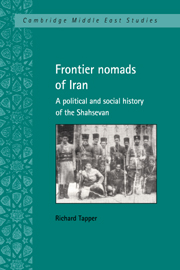Book contents
- Frontmatter
- Contents
- List of illustrations
- Preface
- Acknowledgments
- Note on transliteration
- Glossary
- 1 Writing tribal history
- PART I The Safavid state and the origins of the Shahsevan
- PART II The rise of the Shahsevan confederacy
- PART III The Shahsevan tribes in the Great Game
- PART IV The end of the tribal confederacy
- 11 Pastures new: the effects of the frontier closure
- 12 The Shahsevan, the Constitution, the Great War and after
- 13 Settlement and detribalization
- 14 Conclusion: Shahsevan identity and history
- Appendices
- Bibliography
- Index of topics
- Index of places, peoples, persons, dynasties, parties, companies
- Index of authors quoted or discussed
- Index of tribal names
- Plate section
11 - Pastures new: the effects of the frontier closure
Published online by Cambridge University Press: 05 March 2012
- Frontmatter
- Contents
- List of illustrations
- Preface
- Acknowledgments
- Note on transliteration
- Glossary
- 1 Writing tribal history
- PART I The Safavid state and the origins of the Shahsevan
- PART II The rise of the Shahsevan confederacy
- PART III The Shahsevan tribes in the Great Game
- PART IV The end of the tribal confederacy
- 11 Pastures new: the effects of the frontier closure
- 12 The Shahsevan, the Constitution, the Great War and after
- 13 Settlement and detribalization
- 14 Conclusion: Shahsevan identity and history
- Appendices
- Bibliography
- Index of topics
- Index of places, peoples, persons, dynasties, parties, companies
- Index of authors quoted or discussed
- Index of tribal names
- Plate section
Summary
Azarbaijan at the end of the nineteenth century
Generally, at this time, Iran enjoyed increased security, particularly in the tribal areas and on the frontiers. Economic production increased and in most parts the peasants' lot improved.
Azarbaijan and Shahsevan country seem to have been an exception to this trend. Contemporary reports agree that the peasantry of Azarbaijan suffered under an increasingly decadent and corrupt administration, paralysed by the influence of Russia, which practically controlled the nominations and activities of the most important officials. Lesser officials, from local district governors to tax collectors, acquired their appointments from their immediate superiors, and as there was some competition for offices these were usually auctioned. Agricultural settlements in the southern part of the Shahsevan region, that is the districts of Meshkin, Arshaq, Velkij and Ardabil, were the private property either of wealthy townsmen (officials, merchants and clergy from Ardabil and Tabriz), or of the chiefs of the tribes settled there, particularly in parts of Ardabil district distant from the town. These landowners (molkdar) collected a share of the village produce. In addition the government usually farmed the taxes of villages or whole areas as tiyul assignments to individuals, either as pensions for official or other services, or for a cash payment. Often the landowner also held the tiyul, while in the few villages left as Crown land (khaleseh) the tiyul-holder (tiyuldar) collected both the taxes and the government share of the crop. In other cases the landowner and the tiyuldar were in competition.
- Type
- Chapter
- Information
- Frontier Nomads of IranA Political and Social History of the Shahsevan, pp. 221 - 247Publisher: Cambridge University PressPrint publication year: 1997



